Cambridge CXA80 and CXC Integrated Amplifier and CD Transport
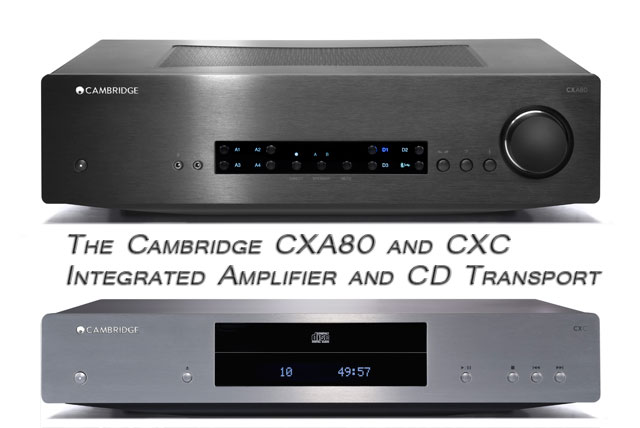
Poking a Hi-Fi Soft Spot
 I have a soft spot for moderately powered, reasonably priced solid-state integrated amps, and subject of this review, the Cambridge Audio CXA80, falls squarely into this category. This type of integrated is an everyman component; the type of thing someone just starting down the audiophile path might seek out as a great core amplifier that offers tremendous value, or as a stepping stone before going completely off the deep end into separates, tubes, arcane hand-built Japanese moving coils, and other deranged esoterica. Either way, this is a well-done piece of gear.
I have a soft spot for moderately powered, reasonably priced solid-state integrated amps, and subject of this review, the Cambridge Audio CXA80, falls squarely into this category. This type of integrated is an everyman component; the type of thing someone just starting down the audiophile path might seek out as a great core amplifier that offers tremendous value, or as a stepping stone before going completely off the deep end into separates, tubes, arcane hand-built Japanese moving coils, and other deranged esoterica. Either way, this is a well-done piece of gear.
The source of my personal nostalgia for this type of amp goes back to my early interest in Hi-Fi: My first credible amplifier, acquired in the summer of 1990, was a Denon PMA-720 that I bought at Purdue Audio in Montclair, NJ. The amp had a MM/MC phono section, a full compliment of balance and tone controls, and 80 watts of juice into 8 ohms. That summer I’d earned enough money to buy some decent gear: the amp, a higher-end Kenwood CD player (yes, there was such a thing in those days), and a pair of floor-standing Advent Heritage three-way speakers. All together, this was a far better than average dormitory rig.
I still use that old integrated, too, in a bedroom system driving a pair of Martin Logan in-ceiling speakers, and it still sounds pretty good. It was the component that I needed at the time, but it was also a better amplifier than I realized when I bought it, and more importantly, it was good enough to meet my needs as a core component for over a decade as my musical tastes changed. It had staying power, and almost thirty years on it continues to make music. It was precisely the sort of really good product that eventually became a gateway to the lifelong enjoyment of good hi-fi gear.
The Cambridge CXA80 has a built-in DAC and host of digital input options that hadn’t yet been invented when I bought the Denon, but it’s priced comparably in today’s dollars, is functionally and aesthetically similar, has identical power output, and could potentially occupy the same role that the Denon played for me a quarter of a century ago.
The Cambridge Audio CXA80 also sounds significantly better than the old Denon, but it too could be a great place to start for a budding audiophile. It’s a fine sounding component that’s good enough to grow with its owner.
I’m Thinkin’
 When I was offered the opportunity to review the Cambridge CXA80 integrated amp and matching CXC CD transport I gave some though about how to approach it. Usually I compare review gear to the other equipment in my own system, writing about the differences a new component brings to the table. But I don’t believe that these Cambridge pieces are trying to compete with the more exotic point-to-point vacuum tube separates that I normally listen to (that sounds so snotty, doesn’t it?), so it seemed more appropriate to review these components for what they are rather than against the other equipment in the house.
When I was offered the opportunity to review the Cambridge CXA80 integrated amp and matching CXC CD transport I gave some though about how to approach it. Usually I compare review gear to the other equipment in my own system, writing about the differences a new component brings to the table. But I don’t believe that these Cambridge pieces are trying to compete with the more exotic point-to-point vacuum tube separates that I normally listen to (that sounds so snotty, doesn’t it?), so it seemed more appropriate to review these components for what they are rather than against the other equipment in the house.
Then I started to think about what kind of integrated amplifier I might be looking for if I was twenty-one today (oh, if only it were true), with a limited budget, buying gear that was good enough to keep for a while. What would it need to do right now, in 2019?
It seems likely that an all-digital domain would be the primary source and there probably wouldn’t be any vinyl involved. In fact, it’s likely there wouldn’t be any physical media at all. I don’t know anyone under the age of thirty who actually buys CDs anymore. I would probably expect to be using my laptop as a source component, running iTunes or possibly some more technically advanced software if I was ambitious.
However, I would also want the amplifier to have some juice: enough power to drive real speakers with some authority and do so without distorting or getting harsh, and I would want that power delivery to be detailed, allowing me hear the music. If I were thinking far enough ahead I’d want something good enough to make the transition into more adult musical pursuits.
And of course it would have to be relatively affordable; attainable for a hard working college student willing to piss away every dime of a summer’s wages on a slick hi-fi, or a music loving young professional, or anyone who wants to invest in a good core component without venturing into debt servitude or bankruptcy.
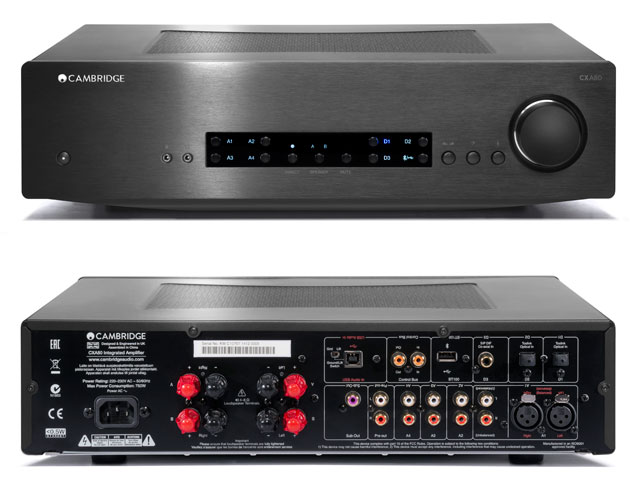
The Cambridge CXA80 Integrated Amplifier
The Cambridge CXA80 integrated amplifier, which retails for $999.99 (C’mon marketing people, you’re not fooling anyone one. It’s a thousand bucks. Just round it up), could play precisely that role for someone contemplating their first entre to better sound, with enough features to minimize the need for any additional source components or expensive cables. It does not have a built in phono stage, but it can play music from any digital source through its built in DAC. There are four sets of RCA and one pair of XLR inputs providing plenty of ways to add analog sources down the road as well. It’s scalable.
 Digital connections include one S/PDIF coaxial, two TOSLINK optical connections, and one USB port. The DAC chip is a Wolfson WM8740 that supports high-resolution files up to 24bit/192kHz for those playing higher bit rates. This isn’t the highest bit rate conversion available and it doesn’t do native DSD or MQA, but it is better than CD quality.
Digital connections include one S/PDIF coaxial, two TOSLINK optical connections, and one USB port. The DAC chip is a Wolfson WM8740 that supports high-resolution files up to 24bit/192kHz for those playing higher bit rates. This isn’t the highest bit rate conversion available and it doesn’t do native DSD or MQA, but it is better than CD quality.
The amplifier also has pretty good grunt. 80 watts per channel may not sound like a lot of power but it’s plenty for most average speaker loads. The CXA80 had no problem driving my 89dB Verity’s with as much volume as I’d want, and it did so without sounding strained.
There was one unexpected oddity: the binding posts to connect the speakers. There’s a plastic flange around them that precludes using speaker cables with spades, and even without the flange they’re so closely spaced that I’m not sure there’d be room to get spades back there. They will work with banana plugs, however. All of my cables have forks so my only option then was bare wire. Fortunately there were a couple of rolls of heavy gauge bulk Monster cable out in the garage left over from installing some in-ceiling speakers. I cut off an eight-foot pair of cables, stripped the ends, and wired everything up. I can’t recall the last time I wired a pair of speakers with the equivalent of lamp cord, but it worked fine. Realistically, someone buying their first better quality components might not be enthusiastic about dropping a lot of extra bread on expensive cables anyway, so this kind of setup seemed reasonable. Plus, while my homemade cords were basic they still sounded good.
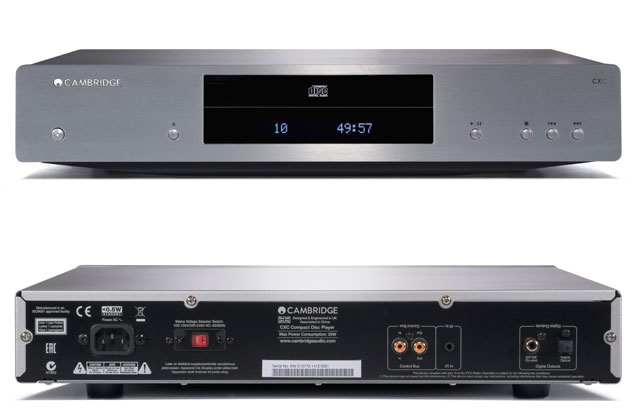
The CXC CD transport
The CXC CD transport offers an opportunity to answer that burning question: What on earth do you do with thirty years of accumulated CDs taking up all that space in the cupboard under the stairs? Seriously. In my house there are thousands of them down there.
 Playing them is one option, of course, and with an amplifier that sports a built in DAC, a full CD player is not necessary. A transport to read the discs and transmit the ones and zeros to the Wolfson chip in the amp is sufficient. That’s exactly what the CXC transport does and that’s all it does, no SACD or multi-channel shenanigans here. It reads good old-fashioned 16-bit Redbook CDs the way Norio Oga intended and sends the data to the amp to be converted into music. It’s also very reasonably priced at $449.99.
Playing them is one option, of course, and with an amplifier that sports a built in DAC, a full CD player is not necessary. A transport to read the discs and transmit the ones and zeros to the Wolfson chip in the amp is sufficient. That’s exactly what the CXC transport does and that’s all it does, no SACD or multi-channel shenanigans here. It reads good old-fashioned 16-bit Redbook CDs the way Norio Oga intended and sends the data to the amp to be converted into music. It’s also very reasonably priced at $449.99.
Although I tried to approach this review from the perspective of a newbie audiophile, a transport is actually geared towards a slightly more (*ahem*) experienced music collector, someone with a large collection of physical media. Very few people actually buy CDs anymore, and very few people would build a music collection around them today, but lots of folks still have them, and despite the opinions of some, they can sound quite good. The CXC takes a legacy format and makes it compatible with the more contemporary feature set of the CXA80. That seems like a smart move, at least for geezers like me.
Truth told, although I listen primarily to vinyl, some of my favorite albums have only ever been issued on CD, particularly some piano trios on ECM or Abdulla Ibrahim’s Sotho Blue. Having a machine with which to play them is still important to me and I suspect to a great number of music fans with collections built in the 1990s and early 2000s.
Let’s Hook It Up
Bringing the CXA80 and CXC online was easy enough. I used a TOSLINK optical cable to connect the two, and the aforementioned wires to the speakers. I also plugged in my Lyric PS-10 phono stage into one of the amps RCA inputs. I used the stock power cables for the review. Turn them on, hit Play, and viola, there is music.
Let’s Shut It Down
Ordinarily, with a piece of solid-state gear I would power it up and just leave it on. My own ancient integrated amp hasn’t been shut off in months. However, from what I understand the European Union has a lot of regulations about the power consumption of electronics and mandates automatic shutoff on new components when no signal is detected for a relatively short period.
If left without a signal or a spun disc for more than about half an hour both the CXA80 and CXC will shut themselves off. I know from experience that my own gear sounds better after it’s been running for a few hours than it does when it’s cold, so this feature seems counterintuitive to getting the best out of the components. Indeed, the CXA80 did sound a little more open and warm after playing continuously for over an hour, making this shutoff feature a bit if an annoyance. But this is hardly the only component on the market suffering from bureaucratic overreach. It’s something we’re going to be seeing more and more of, particularly with components designed in Europe.
Classic Basic Good Looks
Aesthetically the CXA80 and CXC are classic seventeen-inch wide black audio components. The transport has the basic controls: open/close, play, stop, skip and a power button, with a blue-light digital display for track, time and status. The amplifier has buttons labeled A-1 through A-4 for the analog inputs and D-1 through D-4 for the digital ones. There is a large round volume knob on the right and a couple of hidden knobs for balance, bass, and treble adjustment that pop out of the face when they’re pushed. Both units come with remote controls, although the handset for the CXC has far more buttons than the transport has functions to operate.
Listening. After all, that’s why we’re here
No bones about it, the pairing of the CXA80 and CXC do a compelling job of spinning and amplifying compact discs, which is a good thing because they’re the highest resolution digital format I have in the house. The amplifier itself is very quiet and the optical connection from the transport does nothing to degrade that tranquility. In general I would say that they play very cleanly together, with better than average detail retrieval, although without the saturation or extreme warmth that can be had with tubes. I do think they sounded better on the third consecutive CD than they do on the first, simply for having warmed up for a while.
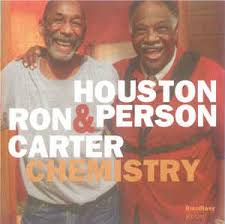 Ron Carter and Houston Person’s album Chemistry [HighNote 2016] is a spacious recording. The horn reveals plenty of breath passing through it, and the reverberations from the room around the musicians are clear. Carter’s bass is tight and detailed, woody and resonant the way it’s supposed to be, but perhaps without the last measure of physical power that one might hear from a higher end setup. It’s still quite satisfying; a very even-tempered, balanced presentation.
Ron Carter and Houston Person’s album Chemistry [HighNote 2016] is a spacious recording. The horn reveals plenty of breath passing through it, and the reverberations from the room around the musicians are clear. Carter’s bass is tight and detailed, woody and resonant the way it’s supposed to be, but perhaps without the last measure of physical power that one might hear from a higher end setup. It’s still quite satisfying; a very even-tempered, balanced presentation.
The CXA80 is also a little drier than I’m used to, but not overly so, and certainly not to the point of sounding sterile or electronic. Were I not accustomed to the glow of twenty-nine vacuum tubes in my own system I likely would not feel this way. The amp throws a pretty good soundstage for both width and height, though it’s not especially deep. The aural image also has good mass. Within the soundstage music really fills up the space and individual instruments are realistically scaled.
The CXA80 has clean treble, rarely becoming strident at the top – that annoying, piercing screech that leaves listeners reaching for cotton balls – and there was no discernable roll-off. The treble was just good all the way around: extended, smooth and natural. The almost non-existent background noise gave the instruments reasonable air and space. Listening to violinist Jonathan Crow lead Mozart the Mason, [Oxingale Records, 2006] a collection of Wolfgang’s string trios, seemingly chosen for their uniformly stately, elegant pace, showed the treble in it’s best light: cleanly extended but also retaining the vibrato and resonance that comes with well recorded bowed instruments. This is one of those recordings where you can almost hear the rosin dusting off the bow and CXC/CXA80 made that abundantly clear.
Computer Based Playback
Although I do occasionally use iTunes at the office, computer playback is not my thing. Nevertheless, being diligent for this review I did try to hook up my Mac laptop to the CXA80 via an AudioQuest USB cable. My MAC was able to identify the CXA80 as a selectable output devise, and as best I could tell, that should have allowed it to play files directly from my laptop. Alas, I never was able to get so much as a peep out of it. I’m sure it was either user error and some unfound setting in my laptop, or possibly just the age of my MAC, but after two hours of trying, reading and re-reading the manual, checking a few Q&A forums and the like, the source of the silence remained a state secret. My wife, who is far more of a techie than I am also tried to get it to work, adjusting additional settings in the MAC that I never knew existed, and she was unable to get it to work either.
This was an unfortunate omission in this review, as it’s likely many buyers of an amp like this would be using some sort of computer-based source. However, following my experience with the CXA80 decoding CDs I don’t have any reason to think that the same DAC wouldn’t do as well or better with higher resolution files originating from a computer, but I was not able to verify it.
Good thing I had records.
Analog Source
 As mentioned earlier, I ran my tube-based phono stage into one of the analog inputs on the CXA80. As I write this, my SOTA is off to Wisconsin for some upgrades, so it’s monaural only using the Miyajima Spirit mono cartridge into a step-up transformer then the MM input on the Lyric PS-10 phono preamp.
As mentioned earlier, I ran my tube-based phono stage into one of the analog inputs on the CXA80. As I write this, my SOTA is off to Wisconsin for some upgrades, so it’s monaural only using the Miyajima Spirit mono cartridge into a step-up transformer then the MM input on the Lyric PS-10 phono preamp.
Using this combination as a source is probably cheating a little. The cartridge, SUT, and phono stage together retail for almost eight times the price of the CXA80, but I’m pleased to report that the amplifier did not embarrass itself in this company. In fact, its neutrality proved to be an asset.
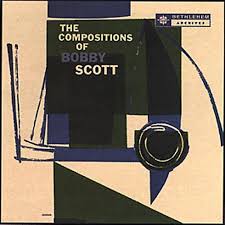 Adding the tubes warmed up the sound significantly, bringing another level of organic realism. An original pressing of The Compositions of Bobby Scott [Bethlehem 1955] was full of textured instrument timbres, dynamics and plenty of color. The amplifier also reflected the soundstage spread that comes with a good monaural setup, high and wide between the speakers. The same thing occurred with Joe Wilder’s Wilder and Wilder [Savoy 1955]. This Van Gelder recording has a somewhat blanketed piano, but the horn is terrifically realistic, breathy and right there.
Adding the tubes warmed up the sound significantly, bringing another level of organic realism. An original pressing of The Compositions of Bobby Scott [Bethlehem 1955] was full of textured instrument timbres, dynamics and plenty of color. The amplifier also reflected the soundstage spread that comes with a good monaural setup, high and wide between the speakers. The same thing occurred with Joe Wilder’s Wilder and Wilder [Savoy 1955]. This Van Gelder recording has a somewhat blanketed piano, but the horn is terrifically realistic, breathy and right there.
The amplifier revealed all the enhanced euphonic qualities that come with glass bottles. This bodes well for the CXA-80’s long-term usefulness. As life and circumstances move along, it’s good to know that the core of the system can reflect new and higher quality source components. The Lyric phono stage makes far richer music than any digital source in my system, and the Cambridge CXA80 – to its credit – passed its character straight through.
Mixing and Matching the Transport
My own CD player is a decade old Cambridge 840C, which was a highly regarded disc spinner in its day. In my system it was the Volvo of CD players, with millions and millions of miles on it when, unfortunately, the transport drawer stopped operating last year. This is not an indictment of the unit. I played the hell out of it constantly for years and years without issue, but moving parts don’t last forever, and despite its ultimate failure I have nothing but good things to say about it.
Besides, there’s nothing wrong with the 840C’s DAC, which is configured to accept digital signals from external sources. I took the opportunity to hook up the CXC transport to the 840C, again via the optical connection, played into my Cary separates. The CXC running into the 840C handily bested the CD player using its own transport. The pairing was quieter, more three dimensional with a larger soundstage, more organic, and just all around better sounding. That’s no small feat for an modestly-priced transport running into a well-regarded CD player.
As a stand-alone component the CXC transport is a real gem, especially for the price. For someone currently using a separate DAC of any sort, who wants to add the capability of spinning a legacy CD collection without breaking the bank, it would be worth the effort to check this thing out. It’s an easy recommendation.
Conclusions
I was fairly impressed with the Cambridge CXA80 integrated amplifier and CXC CD transport. The amplifier’s high-quality sound, either digital or analog, highlights just how much better gear in this price range has become in the twenty-nine years since I purchased that old Denon. In fact, although I’ve had the Cary V12r for ten years now, I’d hazard the opinion that the CXA80 is also better than either of the first two amplifiers that succeeded the Denon in my system (Rotel and Musical Fidelity, respectively). No, it’s not going to take the place of truly high-end gear, and I’m definitely going back to my tubes, but in its context the CXA80 sounds great. If someone were seeking a recommendation for a highly versatile, modestly priced amplifier with a lot of features and above average sound quality I would unreservedly put the CXA80 on the short list of auditions.
The CXC transport played cleanly and organically through the CXA80. It’s got the basic CD player functions and it really doesn’t need more than that. But where it really impressed me was as a solution to a mechanical problem in my system: the death of the front drawer on my 840C. That pairing – the CXC and 840C – was really special and I’m going to look into keeping the transport as a result.
In 2019 it seems like the prices of hi-fi equipment just keep spiraling up and up. You could easily spend more money on a power cord than the combined $1,500 price of entry for these two components, and that fat cable wouldn’t give you nearly as much enjoyment. Cambridge Audio always offers great value and these pieces are cast in the same mold. You could spend a lot more money, but you might not necessarily want to. Well done, Cambridge!


greg simmons
Stereo Times Masthead
Publisher/Founder
Clement Perry
Editor
Dave Thomas
Senior Editors
Frank Alles, Mike Girardi, Key Kim, Russell Lichter, Terry London, Moreno Mitchell, Paul Szabady, Bill Wells, Mike Wright, Stephen Yan, and Rob Dockery
Current Contributors
David Abramson, Tim Barrall, Dave Allison, Ron Cook, Lewis Dardick, Dan Secula, Don Shaulis, Greg Simmons, Eric Teh, Greg Voth, Richard Willie, Ed Van Winkle, and Rob Dockery
Music Reviewers:
Carlos Sanchez, John Jonczyk, John Sprung and Russell Lichter
Site Management Clement Perry
Ad Designer: Martin Perry






Be the first to comment on: Cambridge CXA80 and CXC Integrated Amplifier and CD Transport